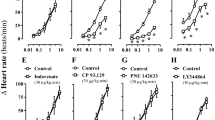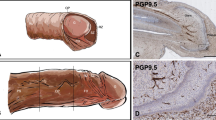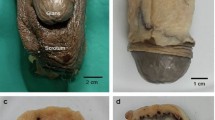Abstract
Our aim was to study the presence of noradrenergic nerves and to characterize the α-adrenergic receptors involved in the contractions to electrical field stimulation and to α-adrenergic agonists of the horse penile deep dorsal vein. Noradrenergic fibres were visualized by immunohistochemistry using an antibody against dopamine-beta-hydroxylase (DBH). For functional studies, the responses of the venous rings to electrical field stimulation and to α-adrenergic agonists (noradrenaline, phenylephrine and BHT 920) were studied in the absence and the presence of noradrenergic transmission- and neuronal sodium channel-blockers (guanethidine and tetrodotoxin, respectively) and of α1- and α2-adrenergic antagonists (prazosin and rauwolscine, respectively). DBH-immunoreactive fibres were present in the adventitia and in the media layer of the venous rings. Electrical field stimulation (0.5–32 Hz) caused frequency-dependent contractions that were abolished by guanethidine (10−6 M) and tetrodotoxin (10−6 M) and reduced by prazosin (10−9–10−7 M) and rauwolscine (3 × 10−8–3 × 10−7 M). Noradrenaline, phenylephrine and BHT 920 induced equipotent contractions of the rings. Prazosin and rauwolscine competitively antagonized the contractions to phenylephrine and BHT 920, respectively. In conclusion, DBH-immunoreactive nerve fibres are present in the horse penile dorsal vein. Both transmural nerve stimulation and α-adrenergic agonists induce contraction of the venous rings through a heterogeneous population of α1- and α2-adrenoceptors.
This is a preview of subscription content, access via your institution
Access options
Subscribe to this journal
Receive 8 print issues and online access
$259.00 per year
only $32.38 per issue
Buy this article
- Purchase on Springer Link
- Instant access to full article PDF
Prices may be subject to local taxes which are calculated during checkout



Similar content being viewed by others
References
Andersson K-E . The pharmacology of the lower urinary tract smooth muscle and penile erectile tissue. Pharmacol Rev 1993; 45: 253–308.
Simonsen U, Prieto D, Saénz de Tejada I, García-Sacristán A . Involvement of nitric oxide in the non-adrenergic non-cholinergic neurotransmission of horse deep penile arteries: role of charybdotoxin-sensitive K(+)-channels. Br J Pharmacol 1995; 116: 2582–2590.
Simonsen U et al. Adrenoceptor-mediated regulation of the contractility in horse penile resistance arteries. J Vasc Res 1997; 34: 90–102.
Recio P et al. Nitrergic relaxation of the horse corpus cavernosum. Role of cGMP. Eur J Pharmacol 1998; 351: 85–94.
Diederichs W, Stief CG, Lue TF, Tanagho EA . Norepinephrine involvement in penile detumescence. J Urol 1990; 143: 1264–1266.
Giuluiano F, Bernabe J, Jardin A, Rousseau JP . Antierectile role of the sympathetic nervous system in rats. J Urol 1993; 150: 519–524.
Saénz de Tejada I et al. Regulation of adrenergic activity in penile corpus cavernosum. J Urol 1989; 142: 1117–1121.
Starke K . α-Adrenoceptor sub-classification. Rev Physiol Biochem Pharmacol 1981; 88: 199–236.
Hedlund H, Andersson K-E . Comparison of the responses to drugs acting on adrenoceptors and muscarinic receptors in human isolated corpus cavernosum and cavernous artery. J Auton Pharmacol 1985; 5: 81–88.
Kirkeby HJ, Forman A, Sorensen S, Andersson K-E . Effects of noradrenaline, 5-hydroxytryptamine and histamine on human penile cavernous tissue and circumflex veins. Int J Impot Res 1989; 1: 181–188.
Esen AA et al. Contractility changes of the deep dorsal penile vein due to serotonin. J Urol 1997; 158: 234–237.
Hsu SM, Raine L, Fanger H . The use of avidin–biotin–peroxidase complex (ABC) in immunoperoxidase techniques: a comparison between ABC and unlabeled antibody (PAP) procedures. J Histochem Cytochem 1981; 29: 577–580.
Oswald W, Guimaraes S, Coimbra A . The termination of action of catecholamines in the isolated venous tissue of the dog. Naunyn-Schmiedeberg's Arch Pharmacol 1971; 269: 15–31.
White FN, Ikeda M, Elsner RW . Adrenergic innervation of large arteries in the seal. Comp Gen Pharmacol 1973; 4: 271–276.
Crowe R, Burnstock G, Dickinson IK, Pryor JP . The human penis: an unusual penetration of NPY-immunoreactive nerves within the medial muscle coat of the deep dorsal vein. J Urol 1991; 145: 1292–1296.
Segarra G et al. Neurogenic contraction and relaxation of human penile deep dorsal vein. Br J Pharmacol 1998; 124: 788–794.
Segarra G et al. Comparative effects of dilator drugs on human penile dorsal vein. Clin Sci 1999; 96: 59–65.
Christ GJ, Maayani S, Valcic M, Melman A . Pharmacological studies of human erectil tissue: spontaneous contractions and alterations in α-adrenoceptor responsiveness with age and disease in isolated tissues. Br J Pharmacol 1990; 101: 375–381.
Recio P, López PG, Fernández JLG, García-Sacristán A . Pharmacological characterization of adrenoceptors in horse corpus cavernosum penis. J Auton Pharmacol 1997; 17: 191–198.
Simonsen U et al. Prejunctional alpha 2-adrenoceptors inhibit nitrergic neurotransmission in horse penile resistance arteries. J Urol 1997; 157: 2356–2360.
Daly CJ, Mc Grath JC, Wilson VJ . Pharmacological analysis of postjunctional α-adrenoceptors mediating contractions to (−)-noradrenaline in the rabbit isolated lateral saphenous vein can be explained by interacting responses to simultaneous activation of α1- and α2-adrenoceptors. Br J Pharmacol 1988; 95: 485–500.
Simonsen U, García-Sacristán A, Prieto D . Penile arteries and erection. J Vasc Res 2002; 39: 283–303.
Acknowledgements
We thank Mr Manuel Perales and Mr Francisco Puente for their technical assistance. We also thank local slaughterhouse (Guadalajara) for kindly donating the horse penis. This work was supported by Grant PM98-0088 of the Spanish Ministry of Education.
Author information
Authors and Affiliations
Corresponding author
Rights and permissions
About this article
Cite this article
Recio, P., Prieto, D., Martínez, M. et al. Immunohistochemical and functional evidence for a noradrenergic regulation in the horse penile deep dorsal vein. Int J Impot Res 16, 486–491 (2004). https://doi.org/10.1038/sj.ijir.3901228
Received:
Revised:
Accepted:
Published:
Issue Date:
DOI: https://doi.org/10.1038/sj.ijir.3901228
Keywords
This article is cited by
-
Physiological regulation of penile arteries and veins
International Journal of Impotence Research (2008)
-
Noradrenergic vasoconstriction of pig prostatic small arteries
Naunyn-Schmiedeberg's Archives of Pharmacology (2008)



